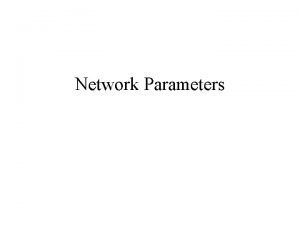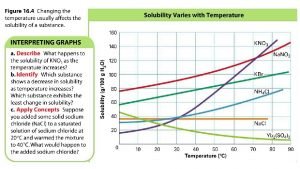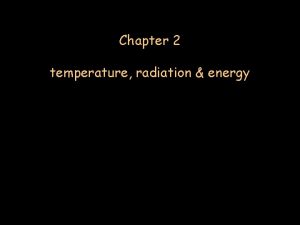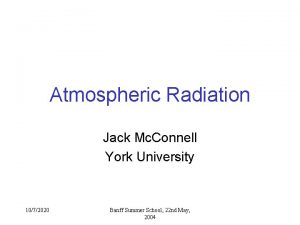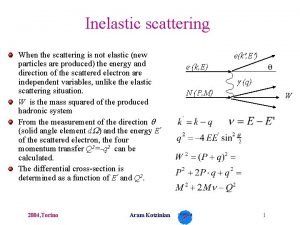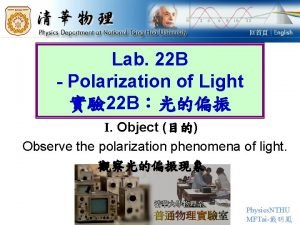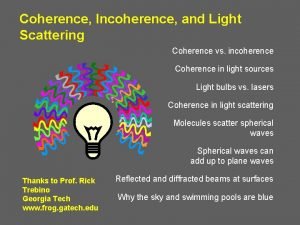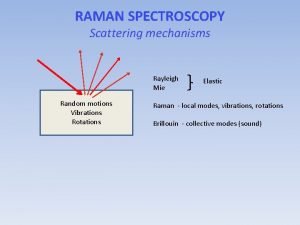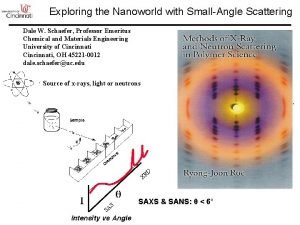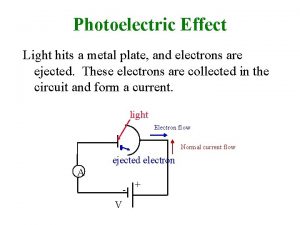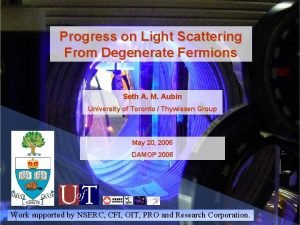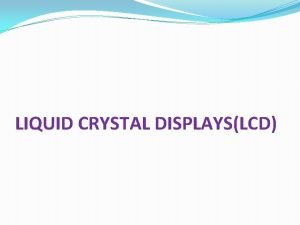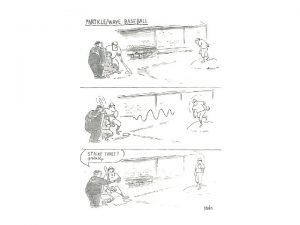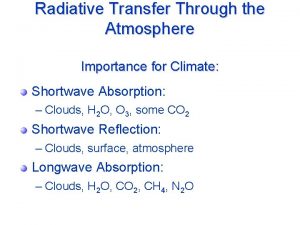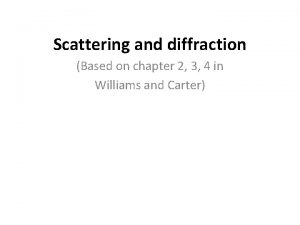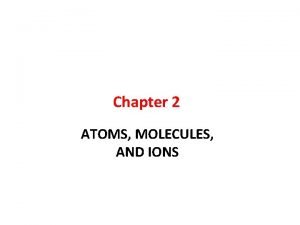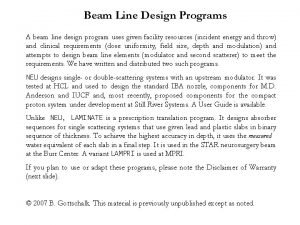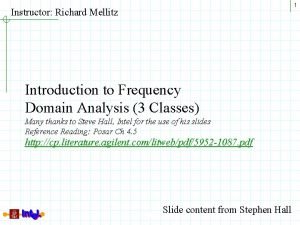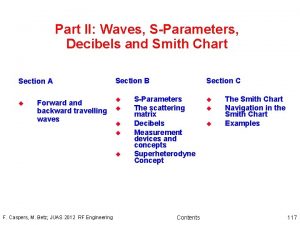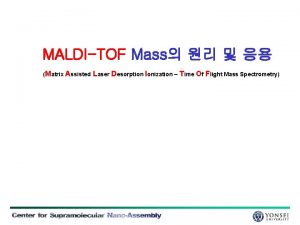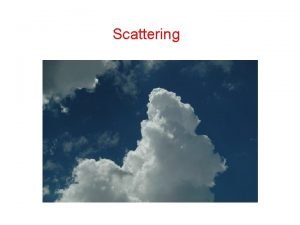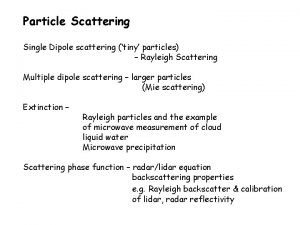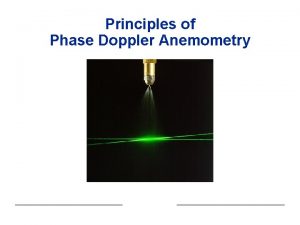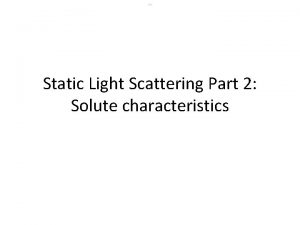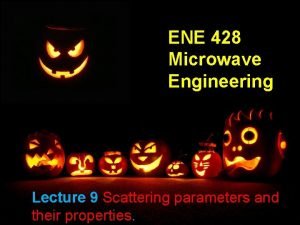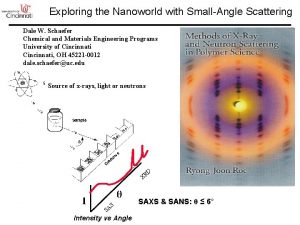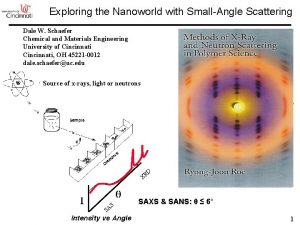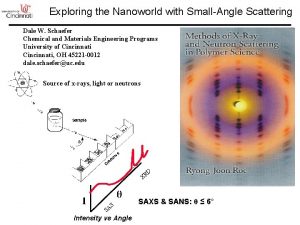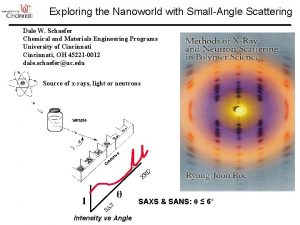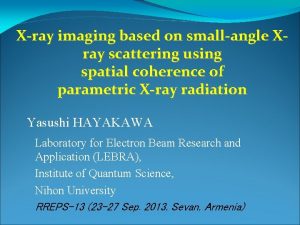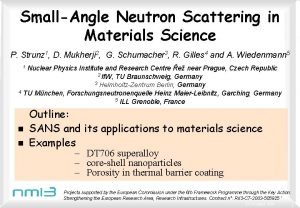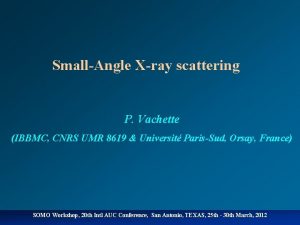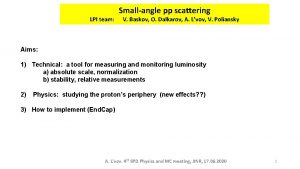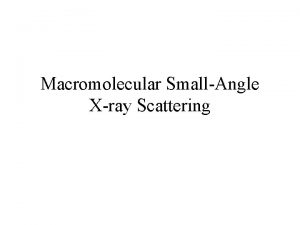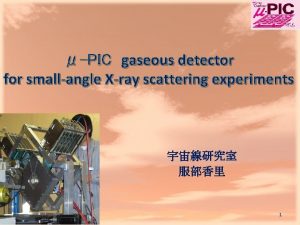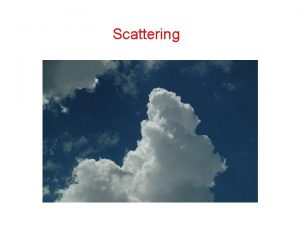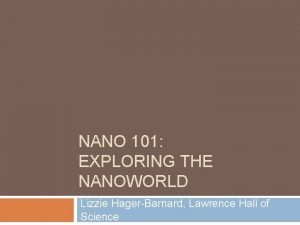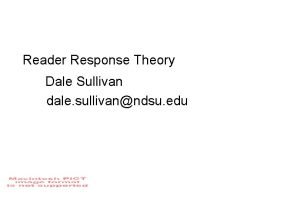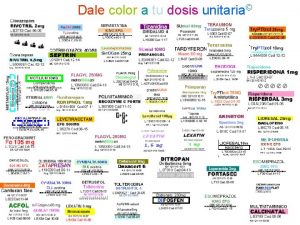Exploring the Nanoworld with SmallAngle Scattering Dale W































- Slides: 31

Exploring the Nanoworld with Small-Angle Scattering Dale W. Schaefer, Professor Emeritus Chemical and Materials Engineering University of Cincinnati, OH 45221 -0012 dale. schaefer@uc. edu Source of x-rays, light or neutrons 1. Basic Concepts 2. Why do Small-Angle Scattering? 3. Imaging vs. Scattering 4. Basic Concepts 5. a) Scattering Vector, Fourier Trns. b) Scattering Length Density Particle Scattering a) Guinier Approximation b) Porod’s Law 6. Fractal Structures 7. Composite Materials D XR AS S 2019 07 24 NX School 1 SAXS & SANS: θ < 6°

Crystals: Bragg’s Law and the scattering vector, q source detector q θ SAXS: θ < 6° d Reciprocal space 2019 07 24 NX School 2 1. 2. 3. 4. 5. Ordered Structures give peaks in “reciprocal” Space. Large structures scatter at small angles. The relevant size scale is determined by 2π/q q is a vector, determined by machine geometry You can’t always determine the real space structure from the scattering data. Problem: Nanomaterials are seldom ordered real space

Disordered Structures in “Real Space” Agglomerates 10µm Precipitated Silica (Na. O) (Si. O 2)3. 3 + HCl —> Si. O 2 + Na. Cl Water Glass Complex Hierarchical Disordered Aggregates 10 nm Difficult to quantify structure from images. Primary Particles 2019 07 24 NX School 3

Hierarchical Structure from Scattering Agglomerate Aggregate Primary Particle Network “Polymer” Four Length Scales Four Morphology Classes Real Space 100, 000 nm 200 nm 10 nm 0. 5 nm Intensity RG = 89 μ -3. 1 SAS -2. 0 Exponents related to morphology -4. 0 -7 10 2019 07 24 NX School 4 Reciprocal Space USAS -6 10 -5 10 0. 0001 0. 1 q [Å-1] ~ Length-1 ~ sin(θ/2) 1 10

Why Reciprocal Space? Isotactic polystyrene foams prepared by TIPS 10 µm 2019 07 24 NX School 5 Jim Aubert, SNL Images miss similarity Ultra-small-angle neutron scattering: a new tool for materials research. Cur. Opinion Sol. State & Mat Sci, 2004. 8(1): p. 39 -47.

Adding up the Phases (Assume x-rays) Wave scattered from one electron Many electrons r 4 r 2 r 1 r 3 scattering length of one electron ρ(r) = bn(r) Amplitude is the Fourier transform of the SLD distribution (almost) Electron density distribution n(r) = number of electrons in a volume element dr = dx dy dz around point r. 2019 07 24 NX School 6 Scattering length density distribution ρ(r) = scattering length in a volume element dr = dx dy dz around point r.

Scattering Length Density (SLD) Distribution Wave amplitude is the Fourier transform of the scattering length density distribution Can’t be measured ρ(r) Scattered Intensity Can’t be inverted What we measure: Square of the Fourier transform of the SLD distribution 2019 07 24 NX School 7

Characterizing Disordered Systems in Real Space Correlation Function of the Electron Density Distribution Throw out phase information r Real space ξ × r r Depends on latitude and longitude. Too much information to be useful. 2019 07 24 NX School 8 Depends on separation distance. Retains statistically significant info. Resolution problems at small r Opacity problems for large r 2 -dimensional Operator prejudice Problems with real space analysis

Imaging vs. Scattering Real space ξ r Reciprocal space Schaefer, D. W. & Agamalian, M. Ultra-small-angle neutron scattering: a new tool for materials research. Curr Opin Solid St & Mat Sci 8, 39 -47, (2004). Pegel, S. , Poetschke, P. , Villmow, T. , Stoyan, D. & Heinrich, G. Spatial statistics of carbon nanotube polymer composites. Polymer 50, 2123 -2132, (2009). 2019 07 24 NX School 9 2π/ξ q

Correlated Holes 2019 07 24 NX School 10

SAXS of Anodized Aluminum 2019 07 24 NX School 11 Hu, N. et al. Interfacial morphology of low-voltage anodic aluminium oxide. J Appl Crystallogr 46, 1386– 1396 (2013).

Scattering from Spherical Particle(s) 2 R ρo v = particle volume N particles I(q) ~ N(ρ - ρo)2 v 2 P(q) 2019 07 24 NX School 12 solvent SLD Form Factor

Particles in Dilute Solution ρ1 ρ2 R RV 2019 07 24 NX School 13 1 particle

Small-Angle Scattering from Spheres Large object scatter at small angles Guinier Regime Diameter = 140 Å Silica in Polyurethane Porod (power-law) Regime 3 mm AFM 2019 07 24 NX School 14 Petrovic, Z. S. et al. Effect of silica nanoparticles on morphology of segmented polyurethanes. Polymer 45, 4285 -4295, (2004)

Guinier Radius Initial curvature is a measure of length Derived in 5. 2. 4. 1 Rg ~ π/q 2019 07 24 NX School 15

Guinier Fits 2019 07 24 NX School 16

Dense packing: Correlated Hard Spheres R ξ Packing Factor = k = 8 ϕ Packing Factor ≅ 6 2019 07 24 NX School 17 Å Å

Colloidal Silica in Epoxy EPON 862 + Cure W+ Silica R=60 Å 500 Å Chen, R. S. et al, Highly dispersed nanosilica-epoxy resins with enhanced mechanical properties Polymer, 2008. 49(17): p. 3805 -3815. 2019 07 24 NX School 18

Disordered Structures in “Real Space” Agglomerates 10µm Precipitated Silica (Na. O) (Si. O 2)3. 3 + HCl —> Si. O 2 + Na. Cl Water Glass Complex Hierarchical Disordered Aggregates 10 nm Difficult to quantify structure from images. Primary Particles 2019 07 24 NX School 19

Using RG: Agglomerate Dispersion Light Scattering dry sonicate 3. 5 µm 2019 07 24 NX School 20 D. W. Schaefer, D. Kohls and E. Feinblum, Morphology of Highly Dispersing Precipitated Silica: Impact of Drying and Sonication. J Inorg Organomet Polym, 2012. 22(3): p. 617 -623. ) hard agglomerate

Beyond RG: Power-Law Scattering Agglomerate Aggregate Primary Particle Network “Polymer” Four Length Scales Four Morphology Classes 100, 000 nm 200 nm 10 nm 0. 5 nm Intensity RG = 89 μ -3. 1 USAXS -2. 0 Exponents related to morphology -4. 0 -7 10 2019 07 24 NX School 21 -6 10 -5 10 0. 0001 0. 1 q [Å-1] ~ Length-1 ~ sin(θ/2) 1 10

Mass-Fractal Objects Real Space d=3 M ~V ~ R 2 Dispersion M~Rd M ~V ~ L 1 d ≅ 2. 5 M ~V ~ R 2. 2 2019 07 24 NX School 22 Mass Fractal Dimension = d

Surface Fractal Dimension Sharp interface S ~ R 2 S ~ Rds fractal or self-affine surface 2019 07 24 NX School 23 2 < ds < 3

Porod Slope for Fractals Structure Smooth Surface Dimensions I(q)=qd -2 d s Porod Slope= ds – 2 dm dm = 3 2019 07 24 NX School 24 - 3 ≥ Slope ≥ - 4 2 < ds ≤ 3 1 ≤ ds = dm ≤ 3 Mass Fractal -4 ds = 2 dm = 3 Rough Surface m - 1 ≥ Slope ≥ - 3

Scattering from colloidal aggregates R r Log I q-d q. R = 1 q-4 qr = 1 Log q Precipitated Silica 2019 07 24 NX School 25

Morphology of Dimosil® Tire-Tread Silica Two Agglomerate length Scales Soft = Physically Bonded Hard = Chemically Bonded 2 Dispersion 116 µm Light Scattering 300 nm Reinforcement USAXS -4 7 µm 2019 07 24 NX School 26 Schaefer, D. W. , Kohls, D. & Feinblum, E. Morphology of Highly Dispersing Precipitated Silica: Impact of Drying and Sonication. J Inorg Organomet Polym 22, 617– 623 (2012). 126 Å

Aggregates are robust Soft Agglomerates shear Hard Agglomerates Ragg 2019 07 24 NX School 27 Aggregates What is the ideal aggregate size?

Conclusion If you want to determine the morphology of a disordered material use small-angle scattering. Tomorrow Nature at the Nanometer Level: SAXS of composites 2019 07 24 NX School 28

Scattering from Fractal Objects: Porod Slopes ds = Surface Fractal Dimension d = Mass Fractal Dimension Small q q. R = 1 ~ Sv/q-x 2019 07 24 NX School 29 Large q Match at q. R = 1

Differential Scattering Cross Section dΩ θ = scattering angle sample Plane wave J 0 Spherical wave JΩ Spherical wave: Flux JΩ = energy/unit solid angle/s Plane wave: Flux J 0 = energy/unit area/s 2019 07 24 NX School 30 or or photons/ unit solid angle /s photons/unit area/s

What do we really measure? Area Scattering cross section depends on sample size: Bad beam length Often called the scattering cross section or the intensity 2019 07 24 NX School 31
 Scattering matrix
Scattering matrix Scattering of light in suspension
Scattering of light in suspension Light scattering
Light scattering Angolo di scattering
Angolo di scattering Scattering efficiency
Scattering efficiency Elastic scattering vs inelastic
Elastic scattering vs inelastic Polarisation by scattering
Polarisation by scattering Coherent vs incoherent scattering
Coherent vs incoherent scattering Mie scattering vs rayleigh
Mie scattering vs rayleigh Small angle scattering
Small angle scattering Photoelectric effect สรุป
Photoelectric effect สรุป Pauli blocking of light scattering in degenerate fermions
Pauli blocking of light scattering in degenerate fermions Coherent scattering
Coherent scattering Dynamic scattering type lcd
Dynamic scattering type lcd Scattering in a central force field
Scattering in a central force field Boltzmann law
Boltzmann law Diffraction and scattering
Diffraction and scattering Rutherford scattering
Rutherford scattering Double scattering
Double scattering Conservation of momentum
Conservation of momentum Coherent scattering
Coherent scattering Medium energy ion scattering
Medium energy ion scattering Scattering matrix
Scattering matrix Scattering matrix
Scattering matrix Dynamic light scattering 원리
Dynamic light scattering 원리 Scattering reaction
Scattering reaction Cross sectional area
Cross sectional area Horizontal
Horizontal Light scattering
Light scattering Rayleigh theory of light scattering
Rayleigh theory of light scattering Scattering reflection
Scattering reflection Scattering parameters in microwave
Scattering parameters in microwave
